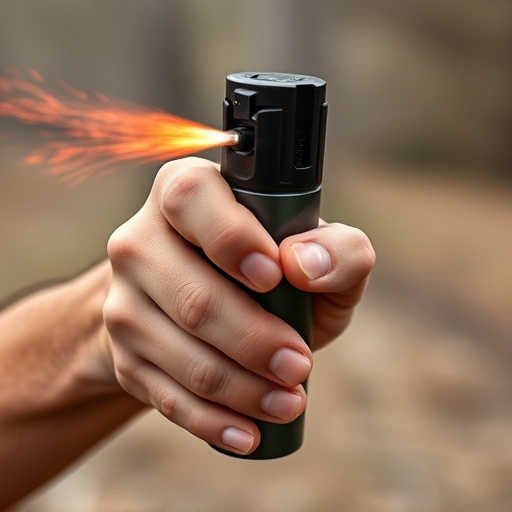Non-lethal pepper spray defense offers a safe yet powerful tool for personal protection, temporarily incapacitating attackers through capsaicin irritation. Its effectiveness hinges on understanding its limitations, proper usage techniques, and local legal status, which varies globally with regulations around age limits, training, and type restrictions. Choosing the right spray based on range, weight, and ease of carry, coupled with regular practice in controlled environments, ensures effective deployment during real-life threats while adhering to regional laws.
“In today’s diverse and often unpredictable world, civilians increasingly turn to non-lethal pepper spray as a personal defense mechanism. This comprehensive guide explores the effectiveness and usability of this powerful tool. We’ll delve into ‘Understanding Non-Lethal Pepper Spray,’ dissecting its mechanics and impact. ‘Legal Considerations’ navigate the complex landscape of civilian use, ensuring responsible deployment. Choosing the right spray involves evaluating factors like potency, range, and ease of use. Learn optimal ‘Deployment Techniques’ for maximum protection in various ‘Real-Life Scenarios’.”
- Understanding Non-Lethal Pepper Spray: A Comprehensive Overview
- Legal Considerations for Civilian Use of Defensive Spray
- Choosing the Right Defensive Spray: Factors to Consider
- Effective Deployment Techniques for Optimal Protection
- Real-Life Scenarios: When and How to Use Defensive Spray for Civilians
Understanding Non-Lethal Pepper Spray: A Comprehensive Overview
Non-lethal pepper spray is a powerful tool for personal defense, designed to incapacitate an attacker temporarily without causing permanent harm. Often referred to as defensive spray, it’s a popular choice for civilians seeking protection in various situations. This type of spray delivers a high concentration of capsaicin, the active ingredient found in chili peppers, which irritates the eyes, nose, and respiratory system, leading to temporary blindness, coughing, and difficulty breathing.
When considering non-lethal pepper spray defense, it’s crucial to understand its effectiveness and limitations. The spray creates a safe distance between the user and the assailant, allowing for an escape or the chance to call for help. It is important to note that while pepper spray can be a game-changer in threatening situations, it may not always stop an attacker immediately. Effective usage involves understanding the spray’s range, wind conditions, and proper application techniques to ensure maximum protection.
Legal Considerations for Civilian Use of Defensive Spray
The civilian use of defensive spray, often referred to as non-lethal pepper spray defense, is a topic that invites scrutiny under legal frameworks. Different jurisdictions have varying regulations regarding its possession and application, primarily due to concerns over public safety and potential misuse. In many countries, civilians can legally carry and use pepper spray for self-defense against imminent physical harm. However, strict rules often accompany this permission, including age restrictions, mandatory training, and limits on the type of spray allowed.
These legal considerations aim to balance personal protection rights with the need to prevent abuse. Pepper spray is generally categorized as a less-lethal or non-deadly force option when compared to firearms. Yet, its use still carries significant consequences if misused. Therefore, understanding local laws and adhering to responsible usage guidelines are crucial for civilians considering defensive spray as a personal safety measure.
Choosing the Right Defensive Spray: Factors to Consider
When selecting a defensive spray for personal protection, several key factors come into play. Firstly, understand the purpose and legal implications in your region. Non-lethal pepper spray is designed to temporarily incapacitate an attacker, providing you with time to escape. However, laws regarding its use vary widely, so it’s crucial to know your local regulations.
Secondly, consider the type of spray. Pepper spray is the most common, causing a burning sensation and temporary blindness. Other options include CS gas and pepper balms, each with unique effects and advantages. Factor in range: some sprays offer a longer reach, ideal for distance deterrence. Additionally, weight and ease of carry are essential if you plan to keep it on your person.
Effective Deployment Techniques for Optimal Protection
When deploying non-lethal pepper spray for civilian protection, understanding effective techniques is key to maximizing its effectiveness. Holding the canister at close range and aiming directly at the attacker’s face ensures the spray reaches the eyes, nose, and mouth, causing temporary blindness, coughing, and difficulty breathing. This immediate disruption can create an escape opportunity or allow for backup to arrive.
Furthermore, practicing in controlled environments helps individuals become familiar with the spray’s range, intensity, and deactivation process. Understanding wind conditions and target distance ensures precise deployment. Remembering to spray from a safe distance, typically 2-3 feet away, prevents collateral damage while maintaining potency.
Real-Life Scenarios: When and How to Use Defensive Spray for Civilians
In real-life scenarios, non-lethal pepper spray defense is a powerful tool for civilians to protect themselves in various threatening situations. Whether facing an attacker on the street or dealing with an aggressive animal, defensive spray offers a quick and effective means of incapacitation. Its non-fatal nature allows users to disable an assailant temporarily, creating an opportunity for escape or help arrival.
The key to successful use is understanding when and how to deploy it. For instance, aiming at the face or eyes can cause severe discomfort and temporary blindness, giving the user a crucial advantage. Users should also be aware of wind direction to avoid inhaling the spray themselves. Regular training and familiarization with the spray’s mechanism are essential to ensure its effectiveness in high-stress situations.
The non-lethal pepper spray defense offers civilians an important tool for self-protection, as illustrated throughout this article. By understanding its mechanics, legal boundaries, and optimal deployment techniques, individuals can make informed decisions about carrying and using defensive spray in various real-life scenarios. Empowering oneself with knowledge is the first step towards becoming a more confident and safe citizen. Always remember to prioritize safety and use only when necessary to deter and de-escalate potential threats.
